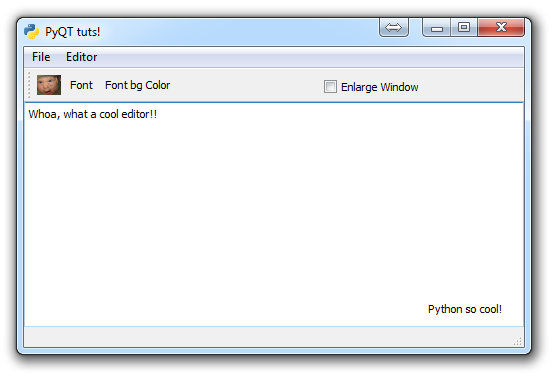PyQT Text Editor

In this tutorial, we're going to cover how to add a text editor to our PyQT application.
First, we create the editor widget:
openEditor = QtGui.QAction('&Editor', self)
openEditor.setShortcut('Ctrl+E')
openEditor.setStatusTip('Open Editor')
openEditor.triggered.connect(self.editor)
Then we add it to the menu with:
editorMenu = mainMenu.addMenu('&Editor')
editorMenu.addAction(openEditor)
Next we have the editor method:
def editor(self):
self.textEdit = QtGui.QTextEdit()
self.setCentralWidget(self.textEdit)
Full code:
import sys
from PyQt4 import QtGui, QtCore
class Window(QtGui.QMainWindow):
def __init__(self):
super(Window, self).__init__()
self.setGeometry(50, 50, 500, 300)
self.setWindowTitle("PyQT tuts!")
self.setWindowIcon(QtGui.QIcon('pythonlogo.png'))
extractAction = QtGui.QAction("&GET TO THE CHOPPAH!!!", self)
extractAction.setShortcut("Ctrl+Q")
extractAction.setStatusTip('Leave The App')
extractAction.triggered.connect(self.close_application)
openEditor = QtGui.QAction("&Editor", self)
openEditor.setShortcut("Ctrl+E")
openEditor.setStatusTip('Open Editor')
openEditor.triggered.connect(self.editor)
self.statusBar()
mainMenu = self.menuBar()
fileMenu = mainMenu.addMenu('&File')
fileMenu.addAction(extractAction)
editorMenu = mainMenu.addMenu("&Editor")
editorMenu.addAction(openEditor)
self.home()
def home(self):
btn = QtGui.QPushButton("Quit", self)
btn.clicked.connect(self.close_application)
btn.resize(btn.minimumSizeHint())
btn.move(0,100)
extractAction = QtGui.QAction(QtGui.QIcon('todachoppa.png'), 'Flee the Scene', self)
extractAction.triggered.connect(self.close_application)
self.toolBar = self.addToolBar("Extraction")
self.toolBar.addAction(extractAction)
fontChoice = QtGui.QAction('Font', self)
fontChoice.triggered.connect(self.font_choice)
#self.toolBar = self.addToolBar("Font")
self.toolBar.addAction(fontChoice)
color = QtGui.QColor(0, 0, 0)
fontColor = QtGui.QAction('Font bg Color', self)
fontColor.triggered.connect(self.color_picker)
self.toolBar.addAction(fontColor)
checkBox = QtGui.QCheckBox('Enlarge Window', self)
checkBox.move(300, 25)
checkBox.stateChanged.connect(self.enlarge_window)
self.progress = QtGui.QProgressBar(self)
self.progress.setGeometry(200, 80, 250, 20)
self.btn = QtGui.QPushButton("Download",self)
self.btn.move(200,120)
self.btn.clicked.connect(self.download)
#print(self.style().objectName())
self.styleChoice = QtGui.QLabel("Windows Vista", self)
comboBox = QtGui.QComboBox(self)
comboBox.addItem("motif")
comboBox.addItem("Windows")
comboBox.addItem("cde")
comboBox.addItem("Plastique")
comboBox.addItem("Cleanlooks")
comboBox.addItem("windowsvista")
comboBox.move(50, 250)
self.styleChoice.move(50,150)
comboBox.activated[str].connect(self.style_choice)
cal = QtGui.QCalendarWidget(self)
cal.move(500,200)
cal.resize(200,200)
self.show()
def color_picker(self):
color = QtGui.QColorDialog.getColor()
self.styleChoice.setStyleSheet("QWidget { background-color: %s}" % color.name())
def editor(self):
self.textEdit = QtGui.QTextEdit()
self.setCentralWidget(self.textEdit)
def font_choice(self):
font, valid = QtGui.QFontDialog.getFont()
if valid:
self.styleChoice.setFont(font)
def style_choice(self, text):
self.styleChoice.setText(text)
QtGui.QApplication.setStyle(QtGui.QStyleFactory.create(text))
def download(self):
self.completed = 0
while self.completed < 100:
self.completed += 0.0001
self.progress.setValue(self.completed)
def enlarge_window(self, state):
if state == QtCore.Qt.Checked:
self.setGeometry(50,50, 1000, 600)
else:
self.setGeometry(50, 50, 500, 300)
def close_application(self):
choice = QtGui.QMessageBox.question(self, 'Extract!',
"Get into the chopper?",
QtGui.QMessageBox.Yes | QtGui.QMessageBox.No)
if choice == QtGui.QMessageBox.Yes:
print("Extracting Naaaaaaoooww!!!!")
sys.exit()
else:
pass
def run():
app = QtGui.QApplication(sys.argv)
GUI = Window()
sys.exit(app.exec_())
run()
The result:

-
PyQT Basic Tutorial
-
PyQT Application Structure
-
PyQT buttons
-
Button Functions with PyQT
-
PyQT Menubar
-
PyQT Toolbar
-
Pop up Message PyQT
-
PyQT Check box
-
PyQT Progress bar example
-
PyQT Dropdown button and QT Styles
-
PyQT Font widget
-
PyQT Color picker widget
-
PyQT Text Editor
-
PyQT open files to edit
-
PyQT file saving
